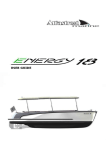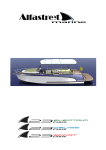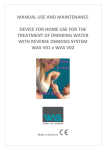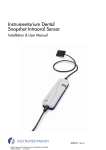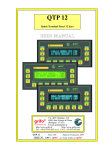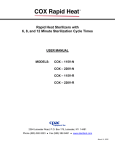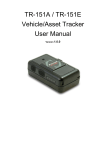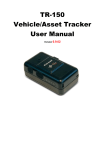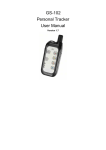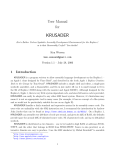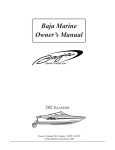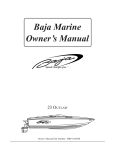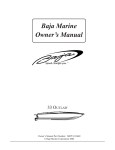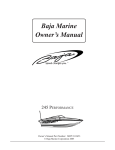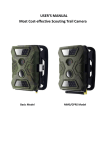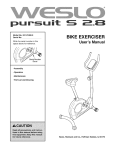Download warning - Alfastreet Marine
Transcript
23SPORT – General manual www.alfastreet-marine.com 2 23SPORT – General manual Index of Content 1 WELCOME ON BOARD............................................................4 2 THE VESSEL...........................................................................5 2.1 ABOUT THE MANUAL.....................................................6 2.1.1 WARNING SIGNS AND SYMBOLS...........................6 2.2 OTHER MANUFACTURER'S USER GUIDES........................6 2.3 YOUR RESPONSIBILITIES .............................................6 2.3.1 NAVIGATION ABILITY...........................................7 2.3.2 REGISTRATION OF THE VESSEL............................7 2.3.3 VESSEL CATEGORIES...........................................7 2.3.4 WEATHER CONDITIONS:......................................8 2.3.5 GENERAL NAVIGATION SAFETY RULES..................9 2.3.6 PLANNING THE NAVIGATIONAL ROUTE..................9 2.4 SUPPLIER'S RESPONSIBILITIES....................................10 2.4.1 WARRANTY PERIOD............................................10 3 THE COMMON SENSE PRINCIPLE.........................................13 4 SAFETY................................................................................13 4.1 GENERAL SAFETY MEASURES.......................................13 4.2 CARBON MONOXIDE....................................................14 4.3 SAFE NAVIGATION.......................................................14 4.4 OBLIGATORY EQUIPMENT ...........................................15 4.4.1 LIFE JACKETS....................................................16 4.4.2 AUTOMATIC AND PORTABLE FIRE EXTINGUISHER ...................................................................................16 4.4.3 WHISTLE, HORN................................................16 4.4.4 VISUAL WARNING TOOLS...................................16 4.5 RECOMMENDED EQUIPMENT.......................................16 4.6 RESCUE EQUIPMENT...................................................17 4.7 EMERGENCY SITUATIONS............................................17 4.8 PHONE NUMBERS FOR EMERGENCY CALLS..................20 4.9 PROBLEMS WITH MANEUVERING THE VESSEL..............20 4.10 INTERNATIONAL REQUIREMENTS..............................21 5 TECHNICAL INFORMATION ..................................................22 5.1 DIMENSIONS ..............................................................22 5.2 FUEL AND WATER CAPACITY........................................23 5.3 SPEED AND AUTONOMY ..............................................23 5.4 CARRYING CAPACITY ..................................................23 5.5 STABILITY .................................................................23 5.6 MOTOR POWER..........................................................23 5.7 CRAFT IDENTIFICATION NUMBER AND BUILDER'S PLATE .........................................................................................24 5.8 MANUFACTURER’S CERTIFICATES.................................25 6 BEFORE THE NAVIGATION....................................................25 6.1 TRANSPORT AND LIFTING OF THE VESSEL...................25 6.1.1 LIFTING THE VESSEL..........................................25 6.1.2 TOWING THE VESSEL..........................................26 6.2 EMBARKING THE VESSEL.............................................26 6.3 FUEL LEVEL AND REFUELING.......................................26 6.4 WATER QUANTITY.......................................................27 6.5 NAVIGATION PLAN.......................................................27 6.6 NAUTICAL CHARTS......................................................28 6.7 WEATHER FORECAST...................................................28 7 MEASURES BEFORE DEPARTURE..........................................28 8 DURING THE NAVIGATION...................................................28 8.1 POSITION OF THE PASSENGERS DURING THE NAVIGATION......................................................................28 8.2 NAVIGATION AND ANCHOR LIGHTS..............................29 8.3 MOTOR (ENGINE) CONTROL LEVER..............................29 8.4 MOTOR ANGLE (TRIM).................................................29 8.5 SAFETY SWITCH FOR SHUTTING DOWN THE MOTOR....30 8.6 IGNITION....................................................................31 8.7 OBSERVING THE SURROUNDINGS DURING NAVIGATION .........................................................................................31 8.8 PASSENGERS SAFETY...................................................31 8.9 AWARENESS AND ENVIRONMENT CARE........................31 9 AFTER THE NAVIGATION......................................................32 9.1 ARRIVAL NOTICE.........................................................32 9.2 STOPPING THE MOTOR................................................32 9.3 VESSEL EQUIPMENT CARE...........................................32 9.4 SWITCHING OFF THE ELECTRICITY CONSUMER............32 9.5 VESSEL PROTECTION...................................................32 10 MAINTENANCE...................................................................33 10.1 CLEANING AND SERVICING THE VESSEL.....................33 10.2 LIFTING THE VESSEL.................................................33 10.3 VESSEL AND EQUIPMENT PROTECTION......................33 10.4 REGULAR SERVICING.................................................34 10.5 STORING THE VESSEL IN WINTER..............................34 10.6 AFTER THE WINTER STORAGE...................................35 11 SERVICING.........................................................................36 12 ALFASTREET MARINE CONTACT INFORMATION...................37 13 GLOSSARY – NAUTICAL TERMINOLOGY...............................38 www.alfastreet-marine.com 3 23SPORT – General manual 1 WELCOME ON BOARD Congratulations for becoming the owner of the vessel 23SPORT. Alfastreet Marine greets you and welcomes you into the company of owners and lovers of vessels. Take your time to carefully read these guides and their attachments. This publication will help you to answer all the questions you might have regarding the vessel. In case you have additional questions, please contact the salesperson. Alfastreet wishes you to feel comfortable and safe on your vessel from the first experience onwards. Please complete the chart below so that the important information about your vessel and its manufacturer shall be gathered in one place and quickly available when you need them. Vessel model:________________________________________________ Vessel identification number:____________________________________ Vessel registration number:_____________________________________ Serial number of propulsion aggregate:___________________________ Manufacturer'sepresentative:___________________________________ Representative's address:______________________________________ Representative's telephone number :_____________________________ Authorised service centre :_____________________________________ Authorised service centre's address :_____________________________ Authorised service centre's telephone number:_____________________ NOTES: _________________________________________________________________________ _________________________________________________________________________ _________________________________________________________________________ _________________________________________________________________________ _________________________________________________________________________ _________________________________________________________________________ _________________________________________________________________________ _________________________________________________________________________ _________________________________________________________________________ _________________________________________________________________________ _________________________________________________________________________ _________________________________________________________________________ _________________________________________________________________________ www.alfastreet-marine.com 4 23SPORT – General manual 2 THE VESSEL The vessel 23SPORT was projected as day cruiser, combining essential modern and classic design of Baltic, Adriatic and Mediterranean spirit. The vessel offers very high level of stability even at top speed of 40knots. Being equipped with cabine, the vessel gives to the passengers even more possibilities of luxury and relaxing staying on vessel. Its excellences are: • stability • safety • precize building • luxury equipment Beside all standard and optional features and accessories, vessel 23SPORT can be equipped with the uique and smart hardtop roof. When lowered it completely closes the deck, and prevent the vessel of dirt, water and uninvited visitors. www.alfastreet-marine.com 5 23SPORT – General manual 2.1 About the manual These guides offer important warnings about safety and your responsibility as the vessel’s owner. All the information provided in this publication is based on the latest information available at the time of printing. Due to our policy of continuous product improvement, we reserve the right to apply changes at any time and without prior notice in the specification of the models as well as in case of cancellation o f any models. Furthermore, we reserve the right to change the specifications, the components or additional equipment whenever and without any obligations to models produced prior the date of such changes. Alfastreet Marine recommends a periodical visit of our website www.alfastreet-marine.si, where you can find additional and new information as well as the FAQ section. What this manual does not give you is a course in boating safety, or how to navigate, anchor, or dock your boat. Operating a power boat safely requires more skills, knowledge, and awareness than is necessary for a car or truck. For safe navigation the course in boating safety and boat manoeuvring is obligatory! Please contact your state authorities for more information. 2.1.1 Warning signs and symbols The manual also provides warning signs. These have different meanings and levels of importance, it is therefore necessary to carefully read the content of the three warning signs below. ! DANGER Failure to consider warnings in such frames will DEFENITELY lead to an accident with severe injuries of the passengers 2.2 ! WARNING Failure to consider warnings in such frames COULD LEAD to an accident with severe injuries of the passengers or even death. ! ADVICE By taking into account the instructions in such frames we INCREASE the safety of the navigation and of the passengers. Other manufacturer's user guides The vessel Energy-23cs features equipment and various components from different manufacturers. The equipment and the components are only mentioned in this manual as all the manuals, user guides, warranty statements and detailed information on the equipment and the components are collected in a special folder (Additional equipment). If you miss any document that you think should accompany the vessel, please contact your vendor or call Alfrastreet d.o.o. on the phone number +386 5 70 72 100. 2.3 Your responsibilities As the owner of the vessel and a participant in the traffic on water, you are responsible for the navigation safety, the traffic safety and the safety of the passengers on board. You www.alfastreet-marine.com 6 23SPORT – General manual should especially take into account how to: • increase of the safety at navigation • learn how to navigate • reduce your risk of collision and injuries at sea, • obtain all registration documents. (contact state authorities for specifications) • expand your navigation area, 2.3.1 Navigation ability Reading, understanding and using this user guide is just as important as learning to adequately control the vessel. This publication IS NOT a course on safe navigation and is also NOT a manual on how to operate, how to anchor and how to tie the vessel. A safe control of the vessel requires more skills, knowledge and awareness than is required for driving a car or lorry. As the driver, owner and user of the vessel you are responsible for it, therefore it is necessary to inform yourself on safety and complete a course on safe navigation. Furthermore, inform yourself on the correct handling of the vessel in case of emergency. As the vessel traffic in closed seas is denser, you should also learn the rules of operating, avoiding and manoeuvring the vessel. 2.3.2 Registration of the vessel Every vessel needs to be included in the register before its first departure. This is carried out in the office authorised for the registration of vessels (usualy Ministry of Maritime Affairs). information, about registration of the vessel, can also be given by local Alfastreet's representative. It is imperative that the registration is done before the first departure. Apart from the registration in the country in which the vessel is most commonly used, it is also necessary, in the event of navigating into the seas of another country, to inform yourself on a possible additional registration of the vessel, as it is required by some countries. The easiest option to do this is at the office which issues the navigation permit. 2.3.3 Vessel categories The vessels are divided into four categories, according to their navigation capacity in various weather conditions: A. Ocean navigation area Highest wind speed: over 40 knots (over 20.6 m/s) Wave height: over 4m The vessel can navigate in the ocean. B. Offshore navigation area Highest wind speed: up to 40 knots (up to 20.6 m/s) Wave height: up to 4m The vessel can navigate in the high seas. C. Inshore navigation area Highest wind speed: up to 27 knots (up to 13.9 m/s) Wave height: up to 2m www.alfastreet-marine.com 7 23SPORT – General manual The vessel can navigate in the coastal area, larger gulfs, lakes and rivers. D. Sheltered coastal area Highest wind speed: up to 15 knots (up to 7.7 m/s) Wave height: up to 0.5m The vessel can navigate in smaller lakes, rivers and canals. Your vessel Energy 23cs satisfies the requirements of the category B. The information means that you would be able to safely navigate with your vessel in such weather conditions. But it is still very important that you inform yourself on the weather conditions before departure, in order to avoid storms or other weather inconveniences. It is also necessary to be aware of any change of weather during the navigation, as bad weather, high waves etc. can catch you very quickly, which can seriously threaten your safety as well as the safety of your passengers. 2.3.4 Weather conditions: Before and during the navigation you should pay special attention to the following: • inform yourself on the weather forecast and weather conditions at sea before your departure from the marina, • a sudden change in the wind speed or direction as well as in the wave height can signal a fast deterioration of the weather, • if you notice a storm approaching, navigate immediately to the nearest marina or quay, • if you are surprised by a storm during the navigation, make sure all passengers are seated and direct the prow towards the wind maintaining enough speed to slowly move forward, • check if all passengers on board have an adequate life jacket, • if you navigate into a dense fog, determine your position, lower your speed and warn other vessels of your presence, • when a thunderstorm is approaching, it is very important to tie the vessel along the coast as quickly as possible and disembark. Do not stay in the water during the lightning, as that would increase your possibility of being struck. Safety in water traffic The water surface does not feature any road lanes, indicators or similar help found in road traffic. Therefore the vessel’s driver must be even more aware of all sides of the vessel and not just the direction of navigation. Failure to consider safety rules and negligence can quickly lead to serious injuries of the people on board or even death, as the consequence of accidents. ! DANGER If the weather forecast is bad, do not departure. Bad weather conditions can lead to accident with tragic consequences. www.alfastreet-marine.com 8 23SPORT – General manual 2.3.5 General navigation safety rules Always be aware of your surrounding during the navigation and follow these rules: • Always conduct the vessel with an adequate speed, which ensures a safe navigation for all passengers on board, • Always pay attention to the traffic in the direction of navigation ad well as around the vessel, especially before you change the direction of navigation. • Reduce the speed of the vessel, pay attention to its surrounding, not only the direction of navigation, and turn on the vessel’s navigation lights when: - the visibility is reduced, - in turbulent water (waves), - in dense traffic. • Always departure after getting enough sleep or after enough rest. In case you fall asleep when controlling the vessel, you can cause it to sink or crash into another vessel or participant in the traffic on water. You are also fully responsible for the damage caused by falling asleep during the navigation. • The vessel features a red and green navigation lights in the corners, and an anchor light on the back of the roof. The navigation and anchor lights must be switched on whenever the vessel is moving, the weather deteriorates or during the navigation at night. • When anchoring on a spot which could be on the navigational route of another vessel, switch on the anchor light located on the vessel’s roof, which is visible 360 o around the vessel. The driver of the vessel must always pay attention to the vessels approaching from all sides. He must also pay attention to the bathers, partly sunk wrecks and other objects in water which are dangerous to the navigation (trunks, reefs, shallows, strong currents, etc). The passengers on your vessel rely on you to take care of their safety and the safety of the navigation by maintaining an adequate speed and by respecting the navigation safety rules. You should also make sure that you do not expose your passengers to danger with quick manoeuvres, such as turning, sudden increasing or reducing of the speed. During weather changes or reducing daylight that result in low visibility, you must adjust the speed of the vessel to the momentary navigational conditions. By doing so, you gain enough time and space to avoid danger. 2.3.6 Planning the navigational route In order to avoid navigating in dangerous waters with potentially dangerous reefs, sunken objects, shallows, dangerous currents and similar perils, it is necessary to prepare, prior to your departure, a detailed navigational route which you plan to follow. During the planing of the route you should use adequate navigational tools which you know how to use and understand their importance. You should also take into account the guidelines of experienced guides and sailors and consider the most appropriate time of navigation for your navigational route area (tide). In case of navigating in unknown waters, without knowing the possible dangers, navigate with low speed and carefully observe the surrounding area as well as the direction of navigation, in order to avoid any www.alfastreet-marine.com 9 23SPORT – General manual potentially dangerous situations. Make sure that others know where you are. Therefore, before departure inform your family members and friends about the following: • the planned direction of your navigation, • the envisaged date and time of return, • the description of the vessel, • the number and age of passengers on board In case of emergency these information can be transferred to the coastal station or the rescue boat crew which will be sent to help you, thus, considerably increasing the possibilities of your rescue and limiting the possibilities of serious injuries of the passengers. It is also important to inform them about your arrival to the destination, as failure to do so could result in a false alarm! 2.4 Supplier's responsibilities The supplier guarantees the vessel with the determined equipment, service and examination of the boat before the supply and at any time after the supply as well as the possibility of complaint in case of proven defects on the vessel. Furthermore, he offers an illustration and presentation of the safety requirements, signs, procedures and instruments as well as an explanation and, if necessary, an illustration of the basic procedures for controlling the vessel. The supplier also examines with the client all the information about the warranty, explains what to do in case of breakdowns and how to obtain a warranty service. Moreover, he provides the complete user guides. If you do not receive all the equipment or if you have problems with the vessel and you wish file a warranty claim, call your supplier or the supplier of the defective component. 2.4.1 Warranty period Alfastreet d.o.o. (Alfastreet Marine) guarantees to all the owners of the vessel Energy 23cs, who purchased the vessel through the manufacturer or his legal representative, to repair all defects and substitute the defected components of the vessel, which occurred within the warranty period. The said period for the vessel Energy 23cs is of one year (12 months), with the exception of the components listed in the following chart, for which the manufactures guarantees a different warranty period. www.alfastreet-marine.com 10 23SPORT – General manual Product Warranty period * Note - Osmosis for all Hull plastic polyester parts of the polyester parts 5 years - Other defects 2 years hull Mechanical damages and damage caused of improper use of part are not covered by this warranty. Deck plastic polyester parts of the deck 2 years Mechanical damages and damage caused of improper use of part are not covered by this warranty. Cabin roof - polyester parts of the cabin roof 3 years Mechanical damages and damage caused of improper use of part are not covered by this warranty. Deck roof - polyester parts of the deck roof 3 years Mechanical damages and damage caused of improper use of part are not covered by this warranty. Gelcoat 2 years Mechanical damages and damage caused of improper use of part are not covered by this warranty. Deck roofHydraulic lifting system 1 years Mechanical damages and damage caused of improper use of equipment are not covered by this warranty. Cabin roof electric lifting system 1 years Mechanical damages and damage caused of improper use of equipment are not covered by this warranty. Wooden parts 1 year Mechanical damages and damage caused of improper use of equipment are not covered by this warranty. Batteries 1 year For warranty conditions and proper use of product, please see attached manufacturer's user manual. Mechanical damages and damage caused of improper use are not covered by this warranty. Battery charger 1 year For warranty conditions and proper use of product, please see attached manufacturer's user manual. Mechanical damages and damage caused of improper use are not covered by this warranty. Propulsion 1 year For warranty conditions and proper use of product, please see attached manufacturer's user manual. Mechanical damages and damage caused of improper use are not covered by this warranty. Propeller 1 year For warranty conditions and proper use of product, please see attached manufacturer's user manual. Mechanical damages and damage caused of improper use are not covered by this warranty. www.alfastreet-marine.com 11 23SPORT – General manual Product Warranty period * Note Radio + speakers 1 year For warranty conditions and proper use of product, please see attached manufacturer's user manual. Mechanical damages and damage caused of improper use are not covered by this warranty. Bow thruster 3 years For warranty conditions and proper use of product, please see attached manufacturer's user manual. Mechanical damages and damage caused of improper use are not covered by this warranty. GPS device 1 year For warranty conditions and proper use of product, please see attached manufacturer's user manual. Mechanical damages and damage caused of improper use are not covered by this warranty. Anchor winch 1 year Stove 2 years Refrigerator 2 years Chemical WC 2 years For warranty conditions and proper use of product, please see attached manufacturer's user manual. Mechanical damages and damage caused of improper use are not covered by this warranty. For warranty conditions and proper use of product, please see attached manufacturer's user manual. Mechanical damages and damage caused of improper use are not covered by this warranty. For warranty conditions and proper use of product, please see attached manufacturer's user manual. Mechanical damages and damage caused of improper use are not covered by this warranty. For warranty conditions and proper use of product, please see attached manufacturer's user manual. Mechanical damages and damage caused of improper use are not covered by this warranty. * NOTICE: • Warranty period is valid only for vessels build for final customer. • Vessels purchased under special conditions, e.g. promotions, exhibition offers, prototype boats, etc., have specific warranty periods and conditions which are determined during the purchase of the vessel. • The warranty claim can be filed only with the original receipt, validated by the manufacturer or his legal representative. www.alfastreet-marine.com 12 23SPORT – General manual 3 THE COMMON SENSE PRINCIPLE Dear customer – user The manufacturer, distributor, designer, constructor, boat examiner and others who contributed in any way to the realization of the vessel and writing of this manual, guarantee to have put the maximum effort into these extensive guides for the safe use of the vessel 23SPORT and to have included all possible situations and problems that you could encounter in the role of the owner and user of the vessel, both on land and on water. Nevertheless, there are various examples or series of events that were not described in this manual or that were described in a different form. Therefore, all the above mentioned persons involved in the project of building your vessel appeal to you, to take into account when using your vessel not only the guides from this manual but also the very important PRINCIPLE OF COMMON SENSE! Navigation can be a fantastic and unique experience which can also lead to tragedies if the safety rules are not respected. Always bear in mind to departure after enough sleep and rest and with responsibility towards yourself and the people around you. This principle should be respected always and everywhere, but we would like to ask the users, to fully respect the said principle especially when using this vessel. Always consider the safety of all the enthusiasts of water-related activities. 4 SAFETY Your safety and the safety of your passengers depend on the way you operate with and maintain the vessel. Reading and understanding the entire manual is therefore necessary for anyone who shall operate the vessel, in order to achieve a safe navigation. It is also necessary to take into account all the additional guidelines provided by the manufacturer or the supplier. On top of that, you need to make sure that you understand the importance and function of all instruments and buttons featured on the dashboard of the vessel prior to your departure. An incorrect use of the vessel is dangerous. The present chapter offers a description of the most important safety rules, which must be observed before, during and after the navigation. 4.1 General safety measures Make sure that all passengers on board of the vessel are aware of and apply the basic safety measures and rules of this manual. The safety of the navigation begins by knowing the dangers which can occur during the navigation and by respecting all the safety rules and measures. Apart from the guidelines of this manual, you should also consider the notifications issued in the marinas, gulfs and destinations featured in the planned navigational route. www.alfastreet-marine.com 13 23SPORT – General manual 4.2 Carbon monoxide When vessel's motor is running it produces carbon monoxide (as exhaust gas). Carbon monoxide (CO) is a deadly gas which you can not smell or taste. CO acts a lot like air. It doesn’t rise or fall but spreads evenly throughout an enclosed space. CO comes in through your lungs and cuts off the oxygen supply to your body, causing death in minutes. Be alert! Symptoms include headaches, nausea and fatigue — but you might think you are just seasick or have the flu. A tail wind can easily carry CO back on board. Dangerous concentration of carbon monoxide can be present when: • air presure is low • a nerby vessel's engine is running • insufficent air flow is presend (in closed cabin) • strong tail wind Precautions to avoid dangerous concentrations of carbon monoxide (CO): • open the cabin door and lift the cabin roof before accesing to the cabin • when motor is running, passengers are not allowed to be seatd on swimming platform • when motor is running, swimmers are not allowed to swim near the engine • do not go under the boat engine cover with the engine running or shortly after the engine has been running. DANGER ! Carbon monoxide is high dangerous gas, and can cause brain damage or death. 4.3 Safe navigation Many boat accidents are often caused by lack of knowledge, failure to respect the safety rules and measures by the drivers of the vessels and their passengers. A correct handling of the vessel, a prompt identification of potential dangers and the application of the safety measures can help to avoid and prevent many dangerous situations. ! WARNING Failure to consider the guidelines related to safety of the navigation can lead to accidents with serious or even tragic consequences. Always use the vessel consciously, carefully and with full responibility towards yourself and the passengres on board, when the vessel is in motion or not. www.alfastreet-marine.com 14 23SPORT – General manual Main safety guidelines: • An incorrect use of the vessel is very dangerous! The driver of the vessel must read and understand all the manuals enclosed with the vessel. • The vessel’s equipment must be in accordance to the local regulations and laws of the country in which we are navigating. • When conducting the vessel, always attach the clip connected to the safety system for switching off the motor to yourself (the best option is to put it on the belt line of your pants). In the event of you falling into the water, this system will make sure that the motor is automatically switched off, thus preventing the uncontrolled navigation of the vessel. • Never conduct the vessel under the influence of alcohol or other psychoactive substances (illegal drugs, sedatives, stimulants, strong drugs, etc.). • During the navigation, you and your passengers should be seated on the sitting surfaces. • During the navigation, it is forbidden to stand or sit on inappropriate places (the edge of the vessel, the motor lid, the roof). Failure to respect this guideline can lead to someone falling into the water or even drowning. • Before switching on the vessel’s motor, you must trim the motor drive up and make sure that the working space of the propeller is free of any foreign objects, which could hamper the functioning of the motor and present a danger during the navigation (branches, ropes, fishing nets…). You also need to check that the propeller isn’t damaged in any way. • Any use of open fire or sparkling objects that could start a fire on board of the vessel is forbidden. 4.4 Obligatory equipment This chapter features a presentation of the equipment which is required by law and is obligatory on board of the vessel, as well as the recommended equipment. it is very important to regularly check the equipment on board and check the technical suitability of singular components. According to the local authority, the obligatory equipment for the navigation in the off shore and sheltered coastal area for vessels without cabins over 5m and vessels with cabin of up to 7m in length is: • an anchor with a rope or chain for anchoring of at least 30m in length, • three ropes for tying with the collective length of at least 40m and suitable strength, • an auxiliary propulsion (motor or sails) or VHF radio station or three red parachute rockets, • bailer of hand pump, • lights and day signals according to the regulations on avoiding collisions at sea, • a concave mirror (for speedboats used for water skiing), • three red torches, • a compass, www.alfastreet-marine.com 15 23SPORT – General manual • life jackets of the same number as the persons on board the boat. Obligatory equipment in text above is obligatory for vessels which navigate in waters of Republic of Slovenia. For more information about rules and obligatory equipment in your country, please consult your local authorities (Port authority, Ministry of Maritime Affairs). 4.4.1 Life jackets If the boat is equipped with life jackets, their number and size must correspond to the number and sizes of the persons on board. Only life jackets with an adequate certificate can be used. 4.4.2 Automatic and portable fire extinguisher The vessel can be (or, if required by law or local jurisdiction, it must be) equipped with an automatic or portable dry powder fire extinguisher, which needs to be periodically checked by an authorized person or organization. Vessel Energy 23CS is optionally equipped with two automatic extinguishers mounted near the engine. 4.4.3 Whistle, horn On board the vessel you must keep a sound tool, such as a whistle or horn, in order to warn others of your presence when the visibility is reduced. Horn can be mounted on top of the roof. 4.4.4 Visual warning tools If you are navigating at sea, you must keep three warning tools on board, which can be used during the day or at night (three red torches or signal rockets). The signal tools must feature a suitable certificate, they must not be expired and they must be kept in a dry and dark space. 4.5 Recommended equipment Along with the obligatory equipment required by law, it is recommended to keep on board the vessel the following objects: • a first aid kit, • maps of the planned navigational route, • a compass, • a GPS, • a marine VHF radio, • an emergency position indicating radio beacon (EPIRB), • a hand pump, • a mosquito repellent, • several ropes, • waterproof battery lights, www.alfastreet-marine.com 16 23SPORT – General manual • • • • • 4.6 replacement batteries for lights, replacing keys for the vessel’s motor, the manual for the vessel’s motor, motor oil, a toolbox with: • combined pliers, • a selection of open end spanners, • an electrical tape (insulating tape), • a hammer, • several replacement components (fuses, light bulbs, screws, etc.), • a replacement propeller. Rescue equipment Even very good swimmers can become quickly tired and drown due to exhaustion, hypothermia or both. Thanks to the rescue equipment, the person who fell into the water can keep himself above the surface of the water with considerably less effort and unnecessary use of body temperature. This raises the chances of survival significantly. The driver of the vessel must make sure that there is one life jacket for each person on board. Before each navigation, he must also indicate to the passengers on board where the life jackets are and how to use them properly. The life jackets must be on easy reach. The best option would be if the life jackets would be worn by the passengers during the navigation. Before purchasing the life jackets, make sure that they feature all the certificates of suitability. It is also necessary to check at least once a year their floatation and look for any damages. ! WARNING Children and nonswimmers must wear and properly fasten the life jackets during the navigation. 4.7 Emergency situations In order to avoid navigating into dangerous areas, sunken wreckages, shallows, dangerous currents and similar, it is necessary to plan a navigational route, by using adequate nautical maps and navigational tools properly and by taking into account the guidelines of experienced drivers and sailors as well as the weather changes and the tide. If you navigate in unknown waters, reduce the speed of the navigation and pay attention to the surroundings in order to avoid collision with another vessel or ay dangers in the water. www.alfastreet-marine.com 17 23SPORT – General manual Important safety guidelines: Before departure, inform your family and friends of the following: • the planed direction of your navigation, • the envisaged date and time of your return, • the description of your vessel, • the number of passengers on board. In case of emergency, such information can be provided to the coastal station, for example, the harbour office, which would increase the chances of a prompt rescue. A. First aid kit: You must keep a complete first aid kit on board. During the navigation you will be situated a long distance from an ambulance station, therefore there should be at least two trained rescue workers on board, who have completed the first aid course. B. Water rescue: If a person falls into the water with below 20 oC, there is a great chance that the person will drown due to hypothermia. Therefore it is very important to pull the person onto the vessel as soon as possible. This can be done in the following ways: • by returning to the person in the water, • by calling the person in the water, • by pulling the person out of the water and on board the vessel. Returning to the person in the water • inform everyone on board about the accident, • carefully observe the person in the water, • carefully navigate towards the person in the water, • if the rescue takes place at night, make sure to direct as much light as possible towards the person in the water to maximise the person’s visibility, • throw a rescue ring to the person in the water, even if this person is already wearing a life jacket. Calling the person in the water • reduce the speed and navigate around the person in the water, • approach the person in the water so that the person is on the windward side of the vessel, • when you are close to the person in the water, switch off the motor to avoid any injuries of the person with the propeller. Pulling the person in the water on board • try to pull the person in the water towards the vessel with a paddle or rope, • do not swim towards the person in the water, unless necessary, • help the person in the water to get on board (the easiest way is across the stern), www.alfastreet-marine.com 18 23SPORT – General manual • • if the person in the water is injured or cannot reach the deck by himself, someone on board must put on a life jacket which is attached to the vessel with a safety rope and the said person picks up the injured person in the water, while the pulling the person on board, be extremely careful as the said person might have suffered injuries to the spine or other parts of the body. C. Fire Fire is a very serious accident which can occur on board, as the vessel can burn down quickly. If you do not manage to put out the fire in a few minutes, focus on your rescuing instead of on extinguishing the fire. Abandon the vessel. Keep the portable fire extinguishers at hand as the starting small fires can be put out quickly and easily. It is also important that the portable fire extinguishers on board are of a suitable type. • Extinguish all smoking objects, • switch off the motor, the fans, the ovens, • if possible, throw the burning objects out of the vessel, • if possible, direct the squirt of the extinguishing agent into the source of the fire and not the top of the flame, • if the vessel features an automatic fire extinguishing system for its motor, wait for 15 minutes after the system’s activation before you lift the cover of the motor. Keep the portable fire extinguisher at hand. • Call for help, • activate the digital call for help (GMDSS), if you have the necessary equipment on board, • put on a lifebuoy and prepare to abandon the vessel. D. Sinking, capsizing of the vessel In case of sinking or capsizing of the vessel: • try to switch off the motor and the electrical equipment before leaving the vessel, • check if everyone on board is wearing properly fastened life jackets, • check if all passengers managed to save themselves from the sinking vessel, • if the vessel is sinking, stay near the vessel, try to board it and activate the help signal (signal rockets), • in extreme cases, try to swim towards the shore. Do not forget that the shore is further than it seems and there is the possibility of drowning due to exhaustion during swimming. E. Collision and flooding In the event of collision with another vessel or object in the water or in the event of flooding: • lower the speed of navigation to reduce the amount of water breaking into the vessel, • switch on the water pump, • use also the manual water pump, • check if all passengers are on board and if anyone is injured, • all passengers must put on the life jackets, www.alfastreet-marine.com 19 23SPORT – General manual • • • activate the call for help, in the event of flooding, put a large cloth, clothing or similar into the hole from which the water is breaking into the vessel in order to stop the flooding. The best option is to put the cloth into the hole from the exterior side of the vessel. In the event of collision, it is necessary to file a report on the accident and notify the nearest coastal station. F. Running aground In the event of the ship running aground: • check if the water is breaking into the vessel. In this event, put a cloth or piece of clothing into the hole before you try to push the vessel back into the water. • Check for any visible damages to the body, the propulsion system or the system for turning the vessel. • Determine if the water current and the wind will push the vessel further into land or if they will help to return the vessel into the water. • Verify the depth of the water around the vessel and the type of floor (sand, stone). Move the vessel away from the spot of collision or running aground towards deep water, but only if this can be anywhere done safely without exposure to danger. • Your vessel should be pulled only by a crew experienced in towing or by a vessel of adequate organizations and institutions (the harbor office, coastal station, marine police, military etc.). Recreational and sports vessels are not intended for towing other vessels. G. Breakdown of the motor or the manoeuvring system In the event of a breakdown of the motor or of the system for manoeuvring the vessel: • switch off the vessel’s motor immediately, • anchor the vessel in order to prevent an uncontrolled navigation (with the current), • check if you can fix the error by yourself. Consult the adequate manuals for descriptions on how to repair the breakdown. • If you are not sure on how to repair the error on your own, activate the call for help. 4.8 Phone numbers for emergency calls Emergency calls can be made by: • GMDSS radio (making distress call) • GSM or satellite telephone, dialing one of distress numbers: • contact centre for emergencies on sea • contact centre for distress calls (112, 911) • local port authorities • police 4.9 Problems with maneuvering the vessel The use of illegal drugs and/or alcohol hampers the safe conduction of the vessel and is also the most common cause of accidents with severe and tragic injuries. The influence of these substances increases in the strong sun, wind and waves, as well as other weather www.alfastreet-marine.com 20 23SPORT – General manual features and leads to irrational and too slow reactions to the dangers on water, resulting in an inevitable accident. Therefore, it is very important that the person conducting the vessel is fully focused, sober, has had enough rest and is entirely concentrated on the navigation. 4.10 International requirements The vessel energy23 was planned and built in accordance with various regulations and standards of the institutions indicated below and which were valid at the time of the vessel’s construction. • Ministere De La Mer – France • Registro Italiano Navale – Italy • Det Norske Veritas – Norway • Securite des Nauires – Canada • J.C.I. (Japan Craft Inspection) – Japan • N.K.K. (Nippon Kaiji Kyokai) – Japan • B.S.I. (British Standards Institute) – England • Ministerio Obras Publicas YTransporters – Spain • EC Recreational Craft Directive – European Community www.alfastreet-marine.com 21 23SPORT – General manual 5 TECHNICAL INFORMATION 5.1 Dimensions The 23SPORT has following dimensions: • • • • • • • • entire height with open roof …….…………........................ 2.6 m entire height with closed roof ………….…......................... 2.1 m height from the water line to the top of open roof ...….... 2.1 m height from the water line to the top of closed roof …..... 1.5 m length (overall) …......................................................... 7.8 m width (overall) ............................................................. 2.4 m depth* …..................................................................... 0.5 m max number of persons on board**.......................... 8 (but not over 680 kg) * can change depending on the number of passengers and load on board the vessel. ** the carrying capacity is not only limited to the number of persons on board, but also to the collective weight of the passengers and the load on the vessel. Figure 1: Dimensions www.alfastreet-marine.com 22 23SPORT – General manual 5.2 Fuel and water capacity The vessel 23SPORT can carry up to 270 liters of fuel and 100 litres of water. Water tank can be filled on starboard side (right), fuel tank can be filled from port side (left) (see Fuel level and refueling Water quantity chapters). 5.3 • • Speed and autonomy Max speed of the vessel : 40 knots Cruising speed of the vessel: 22-26 knots The speed and autonomy data is informative and measured in ideal conditions. The actual value can differ from the envisaged ones due to environmental factors (weather conditions, load on the vessel, the condition of the vessel below the waterline (algae growth and dirt on the hull), the water current, installed propulsion (engine,propeller) … 5.4 Carrying capacity The vessel 23SPORT, is registered for 8 adults. Its carrying capacity is 680 kg, which includes all persons on board and luggage or load. It is very important to take this into account, as, in the event of overloading, the stability of the vessel would be considerably reduced, making the navigation dangerous. 5.5 Stability Your vessel was built in accordance to all regulations and standards related to the stability and navigational characteristics of the vessel determined in the certificate. Each overloading of the vessel can put the stability and navigational characteristics at risk, which could result in the non-stability of the vessel and/or its sinking. Additional guidelines: • the stability of the vessel is reduced if the load is put over the edge of the vessel, • the stability of the vessel is reduced with the breaking of water into the hull or by adding load to the hull. Make sure that water will not break into the vessel’s hull. 5.6 Motor power The types of motor offered by the manufacturer have been carefully chosen to maximize the navigational capacities of the vessel. Therefore, do not install more powerful or bigger motors than the ones we offer. By installing a larger motor than the offered one, you would put in danger the safety of the navigation and the navigational characteristics of the vessel. Moreover, the choice of the propeller installed to the vessel Energy23 is also the result of various tests and calculations, in order to suite the navigational characteristics of the www.alfastreet-marine.com 23 23SPORT – General manual vessel and guarantee its optimal functioning for its purpose and characteristics. Consult the vessel manufacturer before changing the propeller. If you intend to change the propeller, take into account the maximum recommended revolution, as described in the user guide for the motor. The revolutions must never be higher than the recommended ones! In order to achieve the given motor power, the propeller must: • be without damages on its blades, • have no obstructions when rotating (rope or fishnet caught in the blades, or any other deformation to the propeller’s axis, etc.). If you notice any of the indicated damages to the propeller, it needs to be immediately checked by an authorized service centre. It is also recommended to keep a spare propeller on board, in order to change it immediately in case of damages. 5.7 Craft Identification Number and builder's plate The craft identification number(CIN) is located on the right side of the stern. It is the most important identification information about the vessel and it needs to be inserted in all documents, as well as in the order of the vessel. Absence of this information can lead to delays and inconveniences. Other important data include the motor’s serial number and the serial numbers of other motor components. Consult the motor’s user guide to know the locations of the said serial numbers. Figure 2: Craft Identification Number(CIN) The information on the indicated builder’s plate are just as important. The plate is located under the driver’s seat and features information on: • the vessel’s model, • the vessel’s category, • the maximum number of passengers on board, • the vessel’s carrying capacity, • the motor’s maximum power. www.alfastreet-marine.com 24 23SPORT – General manual Figure 3: Builder's plate 5.8 Manufacturer’s certificates Alfastreet Marine respects all the provisions of the CE regulation during the construction process of its vessels. As these vessels are sold all over the world, they respect all the standards based on the costumer’s country. The most common standards are: • ISO, which in Europe includes the CE regulation, • NMMA certification in the USA. 6 BEFORE THE NAVIGATION 6.1 Transport and lifting of the vessel The vessel 23SPORT can be transported on a trailer for the transport of vessels, pulled by a car. The vessel’s towing dimensions do not require a larger vehicle or lorry. However, consult the vessel’s manufacturer or representative before purchasing a trailer. 6.1.1 Lifting the vessel Lowering the vessel into the water with a lift requires caution. It is very important to attach the lifting strap to the right spot. An incorrect attachment of the lifting straps could lead to the slipping of the vessel to the ground and its ruining. The straps must not be www.alfastreet-marine.com 25 23SPORT – General manual attached to the cleats. Their sole purpose is to tie the vessel to the pier and the positioning of the fenders. The spots where the lifting straps can be attached are indicated with a warning sticker. The lifting straps should be positioned as in the picture below. Picture 1: Lifting the vessel 6.1.2 Towing the vessel If the vessel must be towed by another vessel due to a breakdown or if you run out of petrol, empty the batteries or for any other reason, carefully choose where to attach the vessel. Attaching it to the cleats is forbidden! The towing rope should be tied through the bow eye located on bow, under the anchor. 6.2 Embarking the vessel While • • • embarking the vessel, ensure the following: do not overload the vessel, one person can embark the vessel at the same time, help children, the elderly and anyone, who might need assistance while embarking the vessel, • while loading objects from land onto the vessel, be very careful as you might lose your balance and fall into the water injuring yourself. • Arrange the objects on board the vessel as evenly as possible not to endanger the stability of the vessel. The object on the vessel should be at reach to the passengers and carefully stored in the intended storing surfaces. This is especially important when you navigate in turbulent waters or bad weather. 6.3 Fuel level and refueling ALWAYS before navigation check that you have enough fuel for the planned route or if the batteries are enough charged, before your departure. Otherwise, you might not be able to www.alfastreet-marine.com 26 23SPORT – General manual return to the shore which could be dangerous. Level of fuel in tank (reservoir), can be checked on fuel level instrument located on left of steering wheel. Fuel tank capacity is 270 litres. If red indicator is near “E”, as on figure below, it means that fuel level is low. More the indicator is near “F”, higher is level of fuel in the tank (reservoir). Figure 4: Fuel level indicator Fuel can be refuelled via chrome fuel filling plug, marked with sign “FUEL”, located on left (port side) of the deck. After refuelling, cap must be tightened properly. 6.4 Water quantity The vessel Energy 23cs can be eqipped with 100 l water tank. Level of water, if equuipped with level indicator, can be chechked by pressing on button on water level indicator mounted on dashboard near the steering wheel. Regarding on level of water in the tank, LEDs lights up. GREEN LED lights up when tank is full YELLOW LED lights up when tank is ¾ full ORANGE LED lights up when tank is ½ full RED LED lights up when tank is almost empty Figure 5: Water level indicator Water can be refiled via chrome fuel filling plug, marked with sign “WATER”, located on right side (starboard) of the deck. After refiling, cap must be tightened properly. 6.5 Navigation plan The planned navigational route should be kept by a relative, a friend or someone you trust. Keep in touch with this person and inform him of your position. In the event that www.alfastreet-marine.com 27 23SPORT – General manual you do not contact the person you trust in the determined time, he will assume that something went wrong and contact help or organize a rescue operation. 6.6 Nautical charts The nautical charts are important as the view from the lake is often different from the view from land, therefore the driver can easily lose orientation. The nautical charts help him with the orientation and indicate the type and location of limits/obstacles on the lake. 6.7 Weather forecast Check the weather forecast before departure, as the weather is unpredictable and can change quickly. To increase your safety and to prevent any unpleasant surprises, check for any coming storms, the current blowing wind and the condition of the waves. Bad weather, too large waves and strong wind can be dangerous or even deadly. 7 MEASURES BEFORE DEPARTURE Every driver must ensure the following before the departure: • all passengers know the location of the life jackets and how to use them, • children and non-swimmers are wearing the life jackets during the entire navigation, • advise your passengers to put on the life jackets anyway, especially in bad weather, • if the passengers are not wearing the life jackets, the driver takes them out of the compartments, so that they are ready for use immediately, • all rescue equipment and tools are reachable and ready for use during the entire navigation, • the driver knows how to react in emergencies. 8 DURING THE NAVIGATION 8.1 Position of the passengers during the navigation During the navigation, all passengers including the driver of the vessel must be seated. They should not sit on the roof, motor’s cover, the deck and other inappropriate places on the vessel, but in the areas designed for sitting. The sitting areas on the vessel are indicated in the picture below (marked with sign „SEAT“). Sitting on other areas can be dangerous. www.alfastreet-marine.com 28 23SPORT – General manual Figure 6: Seating areas During the navigation, passengers should not: • lean over the deck • be seated on cabin roof (sundeck) • be seated on engine's cover • be standing on swimming platform The driver is responsible for the passengers' supervision during the entire navigation. If necessary he needs to warn them about any inappropriate behaviour, adapt the speed of navigation or even stop the vessel, if he reckons that any of the passengers' behaviour is putting him or other passengers in danger. 8.2 Navigation and anchor lights The vessel features a red and green navigation lights in the corners, and an anchor light on the back of the roof. The navigation and anchor lights must be switched on whenever the vessel is moving, the weather deteriorates or during the navigation at night. When anchoring on a spot which could be on the navigational route of another vessel, switch on the anchor light located on the vessel’s roof, which is visible 360 o around the vessel. 8.3 Motor (engine) control lever Direction and speed of navigation, can be changed with control levers. They are installed on right side of steering wheel. By moving the lever to bow, vessel will move forward, by moving lever to stern side,. The vessel will move backward. Also the speed increases with moving the lever. 8.4 Motor angle (trim) The motors on the vessel Energy 23cs feature a manual positioning of the motor’s angle (trim). Trim can be adjusted by pressing on one of two switches on engine's control lever. The best position for getting the most efficiency from the boat motor depends on the requirements of the situation. Actual position of the trim can be checked on „trim level indicator“ mounted near control lever (trim position indicator is optional and not part of www.alfastreet-marine.com 29 23SPORT – General manual serial equipment). Neutral position The boat motor sits in a neutral position when the propeller is parallel with the top of the water and the motor shaft is at a 90 degree angle. This position normally provides the most efficient operation of the motor and boat in normal conditions. Boat Motor Tilted Down Trimming-in the angle of the boat motor brings the propeller closer to the boat. This is normally done when you have a heavier load in the boat and you want to get the boat running up on plane faster. It has the effect of forcing the bow down and also makes the ride a bit smoother in rough water. Boat Motor Tilted Up Trimming-out the angle of the motor moves the propeller away from the boat and closer to the surface. This is normally done to increase speed and has the effect of lifting the bow. If the prop is tilted up too far the boat will begin to bounce. Trimming-out the motor is also done in shallow water conditions to avoid hitting the bottom or submerged obstacles. The Best Position for the Boat Motor The optimal position depends on the conditions of the water, and the weight that the boat is carrying. Begin with the motor slightly tilted down until you get up on plane. Slowly trim out the angle through the neutral position until the boat starts to bounce. Then trim it in a bit to obtain the most efficient operation. 8.5 Safety switch for shutting down the motor The vessels feature a safety mechanism which shuts down the motor if the driver leaves the motor’s control console. This can happen in the event of the driver’s sickness, passing out, falling over the deck due to turbulent water, strolling around the vessel under the influence of forbidden substances, or if he wanted to shut down the motor for safety reasons. This safety mechanism can prevent a serious accident. A vessel moving without control can present a serious danger to the passengers on board as well as the people in the water around the vessel. Of course, the correct functioning of the mechanism largely depends on the vessel’s driver. As mentioned before, the driver must attach the string of the safety key to himself. If he does so, in the event of an accident, by leaving the control console, he will pull the safety key out of the key hole and cause the motor to shut down. After the safety shut down, position the handle for direction and speed into the neutral position and then insert the safety key into the console located behind the engine control lever. NOTICE: If the security switch is not inserted, the engine won't start! www.alfastreet-marine.com 30 23SPORT – General manual 8.6 Ignition When all passengers are safely seated on board, you can begin the ignition process. This is done in the following steps: • put the main switch of the motor into the „ON“ position, • I the vessel is equipped with electric engine, check the battery charge on the control console of the motor • check if the direction lever is in neutral position • turn ignition key 8.7 Observing the surroundings during navigation When on board the vessel, you should always be aware of your surroundings. Accidents can occur very quickly, therefore you must never leave the vessel uncontrolled, especially when the motor is running. When conducting the vessel, pay attention to what is happening in front of the vessel and be ready to shut down the motors immediately. If an unexpected event/accident occurs, shut down the motors IMMEDIATELY and call for help. Moreover, pay attention to the passengers during the navigation, as they are your responsibility. If any of the passengers fall into the water, shut down the motor immediately and throw the person in the water a rescue ring or any other floating object. 8.8 Passengers safety During the navigation, the passengers must ALWAYS be seated. Any large movements can distract the driver, who is no longer fully aware of the surroundings and the safety of everyone involved. In order to ensure bigger safety, the passengers should wear the life jackets. Do not forget that you are not only in charge of your safety, but also the safety of everyone around you. 8.9 Awareness and environment care Disposal of waste As for the land, the same regulations and moral ethics apply for the disposal of waste on water. Therefore, we kindly ask you to collect the waste which gathered during the navigation in the intended bags and to dispose of them after the completion of the navigation into the designated containers in the marina or wherever you tie the vessel. Throwing the waste over the deck would be very irresponsible and immoral. At the same time we would like to remind you to collect the waste separately. Noise Some areas have specific regulations about noise, which you need to respect. Nevertheless, it would be appropriate and polite not to cause too much noise with music, hooting or screaming. Your vessel is not soundless, therefore try to create an appropriate level of noise. www.alfastreet-marine.com 31 23SPORT – General manual 9 AFTER THE NAVIGATION As for the time before and during the navigation, the time after the navigation requires the application of some guidelines. 9.1 Arrival notice Inform the family members, to whom you trusted the information about your navigation that you have safely reached your destination. Failure to do so could result in an unnecessary call for help or rescue action as they would think that something happened to you! 9.2 Stopping the motor After the finished navigation, place the handle of the control console into the neutral position. By doing so, you stop the rotation of the propeller. 9.3 Vessel equipment care After the finished navigation, all the equipment must be dried (including the life jackets, the ropes, the fenders, paddles and anything else you might want to keep in the storage compartments on the vessel). When the equipment is dry, store it in the compartments on board the vessel, otherwise the humidity on the stored objects will create mould, the objects will oxidise and become useless. 9.4 Switching off the electricity consumer Make sure you switched off all the electricity consumer before you leave the vessel, but most importantly, both main switches must be in the „OFF“ position. Failure to switch off the equipment could lead to an error on the electrical installation and provoke a fire on the vessel. 9.5 Vessel protection Once you have completed all of the above mentioned guidelines, all that remains to be done is to lower the roof with the remote control in order to protect the vessel from the weather and unwanted visitors. Before you actually leave the vessel, check another time that the vessel is correctly and firmly tied to the pier or firmly anchored. If the vessel is anchored, check the position of the vessel regularly, so that if the anchor is „plowing“ the floor, the vessel will not go too far from the anchoring spot. www.alfastreet-marine.com 32 23SPORT – General manual 10 10.1 MAINTENANCE Cleaning and servicing the vessel The vessel Energy 23 requires regular maintenance in order to work as long as possible. The basic tasks can be carried out by you, without any special knowledge. It is very important that: • you regularly clean the vessel. Use mild cleaning products, similar to those used for washing cars. Do not use any aggressive cleaning products or acids. If you need any advice, please turn to the vessel’s manufacturer, representative or the nearest shop which sells nautical equipment. • The pillows should be maintained with the adequate means, otherwise, they will lose their firmness and become damaged due to sun radiation and humidity. • Check the vessel regularly in order to find any damages to the hull, the propeller or the equipment on board in time. • Before charging the batteries, check the feeder cable for any damages. • Before charging the batteries, check if the battery clamps are oxidised. If they are, you need to clean them and recover them with silicone grease. 10.2 Lifting the vessel When lifting the vessel, you need to be careful that the lifting straps are attached to the designated areas, which are indicated with special markings on the vessel’s hull. In the event of an inadequate attachment of the lifting straps, the vessel could lose balance and slip off the lifting straps. As a result, the vessel would fall to the ground and be ruined. 10.3 Vessel and equipment protection Most of the time your vessel is in water and exposed to humidity and bad weather, therefore, the vessel and its equipment are also exposed to oxidation, algae, dirt and other inconveniences. This chapter describes how to prevent these inconveniences. Algae on the hull The gathering of algae on the vessel under the waterline presents a great resistance and therefore it reduces the vessel’s autonomy. If this occurs, it is necessary to lift the vessel out of the water and clean the hull. In order to prevent the growth of algae in the hull, you can use special products and paints. Before deciding on this procedure, consult the manufacturer or authorized service centre about choosing the right protective substance and procedure. Inadequate protective substances or procedures can ruin the hull and therefore create more damages than benefits! Metal parts Because the vessel is most of the time in water and moisture, is very important, that all metal parts mounted on vessel (eg. hydraulic cylinder, cleat, flagpole) are regularly www.alfastreet-marine.com 33 23SPORT – General manual inspected and cleaned. If you see any damage, it is necessary to immediately replace it with a new one. If you find traces of corrosion, you need to clean the metal part with soft cloth and polishing paste which you received with the vessel. Metal equipment can't in any way be cleaned with any scrapers, metal brushes or meshes. Stainless surfaces Even the stainless and chrome surfaces are not entirely resistant to corrosion and can damage during a prolonged exposure to water and especially hoarfrost. It is possible to prolong the lifespan of the mentioned parts with regular cleaning and adequate maintenance. When you notice any damage, replace the damaged component with a new one. Damaged components and equipment on the vessel can present a danger for the passengers and other participants in traffic. Cleaning the vessel As mentioned before, a prolonged exposure to water, dirt and weather damages the vessel and its equipment. Therefore, it is very important to regularly clean all the components of the vessel with adequate mild cleaning products and freshwater. The carpets and pillows must be cleaned with a vacuum cleaner. The vessel is made of reinforced fiberglass, which means that its maintenance and cleaning are not difficult. After cleaning the vessel, it is also important to apply to the components adequate products (protective creams for leather, wood, plastic, rubber etc.). Maintaining the vessel is similar to maintaining your car. It requires regular cleaning. Never use aggressive cleaning products, such as acids or diluters. In the event of a warranty claim, for which it would be determined that the components or the equipment were damaged due to an inadequate maintenance or use of inadequate cleaning products, the warranty shall not be allowed. The warranty conditions do not apply for such circumstances. 10.4 Regular servicing The vessel Energy 23 does not require special servicing, it only needs regular cleaning and maintenance. The same does not apply for the motors and batteries. To know which regular servicing are needed and in which intervals, please consult the user guides issued by the manufacturers of the mentioned components. 10.5 Storing the vessel in winter Storing the vessel in winter, when the vessel is not used for a prolonged time, requires special preparations. This is also the period when you have the chance to lift the vessel out of the water and carry out thorough checks and maintenance of the vessel and its equipment. If the said period is longer, it is also advisable to remove the batteries from the vessel and store them in a warmer place, where it would also be easier to recharge them, thus reducing the level of discharge. Before exposing the vessel to the temperatures below freezing point, it is necessary to check that the vessel does not contain any water (in www.alfastreet-marine.com 34 23SPORT – General manual pumps, tanks, storing surfaces etc.), as it would damage the said parts in the event of freezing. Damages of the vessel’s components, caused by freezing water is not included in the warranty conditions. You also need to take into account the guidelines on storing during winter, which are mentioned by the manufacturers of the motor and other installed equipment in their user guides. The most important tasks before the winter storage: • pump out all the water from the hull, • empty the water pump which you used to remove the water from the hull, • clean the hull thoroughly, • clean the deck thoroughly, • clean the interior of the vessel thoroughly, • air and leave to dry the vessel and its equipment for a few days, • apply the protective wax to the hull, • if possible, remove the batteries from the vessel and keep them in a dry and dark place (storage or garage), recharge them, • make sure that the roof is completely lowered. For a better insulation, you can apply between the roof and the hull an insulation foam with the diameter of 5 cm, which is also used for insulating the heating pipes. . 10.6 What • • • • • • • • After the winter storage you need to do after winter and before the first navigation: check that the batteries are fully charged, check that the control system is working properly, follow the guidelines of the motor manufacturer about the first ignition after the winter storing. As this requires special skills, you can ask for assistance or advice the authorized service centre or the vessel’s manufacturer. Check all the storing surfaces, the motor and battery area, as well as other similar hidden parts of the vessel, to make sure that any parasites or other animals did not inhabit these parts during winter. Check the oil level of the motor, check for any damages to the motor, the water pump and the sliding roof due to freezing, check the attachment of the cleats and other parts used for tying and anchoring the vessel, check that the propeller and its rotation are flawless. www.alfastreet-marine.com 35 23SPORT – General manual 11 SERVICING In the event of damages or if servicing is necessary due to other reasons, please turn to the manufacturer of the vessel energy23 or the store where you bought the vessel. In order to find the nearest store, visit the website www.alfastreet-marine.si, call the number +386 5 70 72 100, or send us and email to the address [email protected]. If you are not satisfied with the servicing: • consult the person authorized for servicing at the place where the vehicle was repaired on matters related to the warranty, • if the authorized service centre does not repair the error in the determined period of time, or if you are not satisfied with the service, turn to the manufacturer. Every owner of the vessel must be aware that regular servicing and maintenance are necessary to guarantee a long lifespan of the vessel and, most importantly, to guarantee a safe navigation. Ask the manufacturer or supplier for an offer on regular services or maintenance of your vessel. If you own a large number of vessels and you have your own service team, the manufacturer or its representative can organize a training course for your colleagues in order to enable them to undertake almost all service tasks on their own. Alfastreet Marine also offers “on-line” support for any questions about maintenance and servicing of the vessel: Service centre Alfastreet-marine: Dejan Ravbar Partizanska 129, 6211 Sezana Si (Slovenia) tel. n.: +386 5 7072 115 email: [email protected] www.alfastreet-marine.com 36 23SPORT – General manual 12 ALFASTREET MARINE CONTACT INFORMATION Alfastreet d.o.o. - Alfastreet MARINE Partizanska 129, SI-6210 SEŽANA, SLOVENIA tel. n.: fax: +386 5 70 72 100 +386 5 70 72 127 website: www.alfastreet-marine.com Contact person: Tjaša Luin Peric Chief executive officer email: [email protected] tel. n.: +386 5 70 72 101, mobile: +386 41 388 166 Technical support: Dejan Ravbar email: [email protected] tel. n.: +386 5 70 72 140 QR codes: WEB page www.alfastreet-marine.com www.alfastreet-marine.com 37 23SPORT – General manual 13 GLOSSARY – NAUTICAL TERMINOLOGY ABEAM - object 90 degrees ( 90°) to center line on either side of boat. ABAFT - a point on a boat that is aft of another. ABYC - American Boat and Yacht Council, Inc.(USA) AFLOAT – On the water. AFT - Toward the rear or stern of the boat. AGROUND – Touching bottom. AMIDSHIP (MID SHIP)– Center or middle of the boat. ANCHOR – (1) An iron casting shaped to grip the lake bottom to hold the boat. (2) The act of setting the anchor. ANODE – An electrode carrying a positive charge. ASHORE – On the shore. ASTERN – Toward the stern(rear). BAIL – To remove water from the bottom of the boat with a pump, bucket, sponge, etc. BALLAST – Any solid or liquid weight placed in a boat to increase the draft, to change the trim. BEAM – The widest point on the boat.(the maximum width of a boat.) BEARING – Relative position or direction of an object from the boat. BILGE – the lowest part of the hull on the inside where fluids collect. BOARDING – To enter the boat. BOUNDARY WATERS – A body of water between two areas of jurisdiction; i.e., a river between two states. BOW – The forward part of the boat. BOW EYE - bolt with looped head mounted on extreme forward part of bow, used for towing or tying up boat. BUILDER'S PLATE – A plate that provides maximum load capacity and engine horsepower rating information. It is located in full view of the helm.(see also CAPACITY PLATE) BULKHEAD – Vertical partition (wall) in a boat. BUNKS – Carpeted trailer hull supports. BURDENED BOAT – Term for the boat that must "give-way" to boats with the right-ofway. CAPACITY PLATE – A plate that provides maximum weight capacity and engine horsepower rating information. It is located in full view of the helm.(see also BUILDER'S PLATE) CAPSIZE – To turn over. CAST-OFF – To unfasten mooring lines in preparation for departure. CATHODE – An electrode carrying a negative charge. CAVITATION – A phenomenon in which low pressure within a liquid allows vapor bubbles to form. CENTER LINE – A lengthwise imaginary line which runs fore and aft with the boat’s keel. CHINE – The point on a boat where the side intersects (meets) the bottom.(meeting juncture of side and bottom of boat.) CHOCK deck fitting, used as a guide for mooring or anchor lines. Also, a wedge to www.alfastreet-marine.com 38 23SPORT – General manual stop wheels from rolling. CIN - Craft Identification Number(ISO 10087) CLEAT – deck fitting with arms or horns to which lines are tied or made fast. COCKPIT - the open space from which a boat is operated. CONSOLE – Also called helm. The steering wheel area of the boat. CRANKING BATTERY – The main battery used for engine starting and electrical circuits. CURRENT – Water moving in a horizontal direction. DEADRISE – Transverse angle of the bottom of the hull. DECK – upper structure which covers the hull between gunwales. DOWNWIND - in the direction the wind is blowing toward DRAFT – The depth of the boat below the water line, measured vertically to the lowest part of the hull. (depth of water required to float boat and its propulsion system.) ELECTROLYSIS – The break-up of metals due to the effects of galvanic corrosion. FENDER – Devices built into or hung over the sides of a boat to prevent the boat from rubbing or chafing against other boats or piers. FORE – Toward the front or bow of the boat. Opposite of aft. FREEBOARD –The distance from the waterline to the upper surface of the side of the deck. (height of exposed hull from water line to deck.) FUEL SENDING UNIT – The electrical device that is mounted on the outside of a built-in fuel tank and controls the dashboard fuel gauge. GIVE-WAY BOAT – (1) Term for the boat that must take whatever action necessary to keep well clear of the boat with the right-of-way in meeting or crossing situations. (2) The burdened boat. GROUND TACKLE - general term referring to anchors, anchor lines, etc. GUNWALE – (pronounced gun'l) - where the hull and deck come together; the "sides" of the boat in the cockpit area. HATCH - an opening in the deck to provide access below. HEAD – toilet or toilet area in a boat. HEADROOM - vertical distance between the deck and cabin or canopy top. HELM – The steering wheel or command area.(steering and controls console.) HULL – The structural body of a boat below the deck.(the lower part of a boat beneath the deck and cockpit that provides buoyancy to float the weight of the craft and its load.) HYPOTHERMIA – A physical condition where the body loses heat faster than it can produce it. IN-LINE FUSE – A type of protective fuse located in the power wire of a direct current (DC) circuit usually near the battery. KEEL – The lowest portion of the boat; extends fore and aft along the boat’s bottom. KNOT - unit of speed in nautical miles per hour.(1,852km/h) LEE - the side that is sheltered from the wind. LINE – All rope in a boat or on the dock is referred to as “line.” LIST – Leaning or tilt of a boat toward the side. MAKING WAY – Making progress through the water. MARINE CHART – Seagoing maps showing depths, buoys, navigation aids, etc. MIC- Manufacturer’s Identity Code www.alfastreet-marine.com 39 23SPORT – General manual MID SHIP (AMIDSHIP) – In the vicinity of the mid-length of a boat, technically the exact half way between the bow and the stern. MOORING – An anchor, chain, or similar device that holds a boat in one location. NAVIGATION AID – Recognizable objects on land or sea such as buoys, towers or lights which are used to fix position to identify safe and unsafe waters. NAUTICAL MILE – 1,852km NMMA – National Marine Manufacturer’s Association(USA) NO-WAKE SPEED – The speed at which a boat travels to produce an imperceptible wake. PFD – Personal flotation device, life jacket or preserver. PITOT TUBE – Speedometer pickup tube. PLANING HULL – A hull designed to lift, thereby reducing friction and increasing efficiency. PORPOISE – A condition in which the bow bounces up and down caused by trimming the engine too far out. PORT – (1) The left side of a boat when facing the bow(forward). (2) A destination or harbor. PRIVILEGED BOAT – Term used for the boat with the right-of-way. PROPELLER PITCH – Theoretical linear distance the propeller would move ahead during one complete revolution of it were turning with zero slippage. PROPULSION – is the mechanism or system used to generate thrust to move the boat across water. RIGHT-OF-WAY – Term for the boat that has priority in meeting or crossing situations. The stand on or privileged boat. RUB RAIL – The rubber extrusion that is fastened over the hull and deck joint. RUDDER – vertical metal device used to steer the boat(Movable fixture at the stern used for steering.) RULES OF THE ROAD – Regulations for preventing collisions on the water. SACRIFICIAL ANODE – Metal parts fitted to the hull of boat to provide a transfer of ions to the cathodic part of an electrolytic coupling and so protect other parts of the boat that would otherwise waste away through electrolysis SCUPPER - hole permitting water to drain overboard from deck or cockpit. SHEER - curve or sweep of the deck as viewed from the side. SLIP – The linear distance between the pitch (or advance) and the actual distance the propeller moves straight ahead through the water. SNUB - to check or tighten a line suddenly. SPEEDOMETER PICKUP TUBE – Also called pitot tube. The plastic device that extends below the bottom of the boat. It connects to the speedometer with plastic flexible tubing. SPRING LINE – A mooring rope oriented at a small angle to the boats centerline, usually attached to the boat mid ship. STAND ON BOAT – Term for the boat that must maintain course and speed in meeting or crossing situations. The privileged boat. STARBOARD – The right side of the boat when looking towards the bow.(forward) STERN – The aft(rear) end of a boat. STERN DRIVE - outboard unit of an inboard/outboard (I/O) engine installation. www.alfastreet-marine.com 40 23SPORT – General manual STOW – To put away. To store cargo in a storage locker. STRINGER – Members under the floor that stiffen the hull bottom.( longitudinal members fastened inside the hull for additional structural strength.) SURGE BRAKES – A type of trailer braking system designed to automatically actuate when the tow vehicle’s brakes are applied. TRANSDUCER – The unit that sends/receives signals for the depth sounder. TRANSOM – The transverse beam across the stern.(the rear part of the boat across the back, to which the drive unit and swim platform are attached.) TRIM – Fore to aft and side to side balance of the boat when loaded. UNDERWAY – Boat in motion; i.e., not moored or anchored. UPWIND - in the direction the wind is blowing from. USCG – United States Coast Guard VISUAL DISTRESS SIGNAL – A device used to signal the need for assistance such as flags, lights and flares. WAKE – The waves that a boat leaves behind when moving through the water.(disturbed water that a boat leaves behind as a result of forward motion.) WATERLINE - The line of the water’s edge when the boat is afloat. WATERWAY - A navigable body of water. WETTED SURFACE – The area of the immersed hull plus underwater gear. WINDWARD - toward the direction from which the wind is blowing. 14 August 2015 www.alfastreet-marine.com 41









































